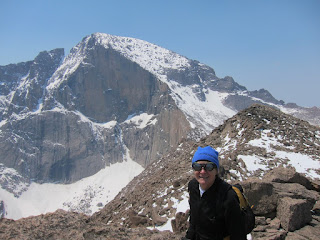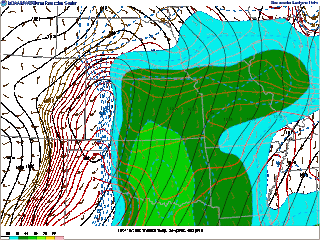Thursday, May 31, 2012
Mount Lady Washington - Summit
I met up with Cindy McCloskey and Amanda Cooper on May 26th to re-attempt an ascent of Mt. Lady Washington (MLW). We got an alpine start and made good time to tree line. As we approached Granite Pass, we caught up with my mother, who decided to camp out in Goblin's Forest during the night so that she could get a head start up the trail (due to her slower pace). At Granite Pass, Cindy and Amanda decided to turn around, so my mother and I switchbacked up to the start of the ridge leading to the summit of MLW. I made an ascending traverse just west of the ridge, which helped me avoid several steep false summits. I gained the summit fairly quickly, and took in one of the best views in all of Colorado...the Diamond of Longs Peak, the immense northern face of Mt. Meeker, and Chasm Lake, which was located a 1000 or so feet immediately below. It took an hour for my mother to catch up and summit, but she kept at it, despite her hatred for bolder hopping...I was very proud of her. After numerous photos were taken, I started back down the ridge. Halfway down the ridge, I turned east and descended the steep face of MLW. I already knew what I was in for, loose rock on a steep slope, and occasional shin to knee deep snow fields. After battling through the descent, I reached the main trail, and hiked back to the parking lot in 3 hours.
Thursday, May 03, 2012
Live From the Storm Prediction Center - The 14 April 2012 Tornado Outbreak
Pictures posted below are from 14 April 2012. CNN went live from the Storm Prediction Center on an hourly basis, updating viewers on the evolving tornado outbreak over the central and southern plains. Steve Weiss had a starring role in these live broadcasts.
Meteorological data below the CNN pictures highlights a few environmental features present during this outbreak. The large-scale pattern featured an upper trough over the southwestern CONUS, with a strong upper-level jet spreading downstream into the Great Plains. This induced cyclogenesis over the high plains, favoring the development of a southerly low-level jet from Texas into Kansas, and aided in establishing a broad moist/unstable warm sector east of the surface dryline. This setting is fairly typical of Great Plains tornado outbreaks. Initially, forecasters believed a substantial tornado threat would develop along the warm front lifting into Nebraska. However, late morning/early afternoon thunderstorms lifted northward across the warm front into Nebraska, and stabilized the airmass, which substantially reduced the potential for tornadoes.
Meanwhile, discrete/isolated supercells developed along the dryline over northwestern Oklahoma and southwestern Kansas. These long-lived storms moved northwest across the region, but struggled to produced tornadoes initially. Near sunset, the low-level jet strengthened to near 70 kt, which dramatically increased low-level vertical wind shear. In addition, the thermodynamic environment continued to favor surface based supercells. The RUC proximity sounding from KEND in northern Oklahoma shows a potent combination of shear and instability present across the area during the early night, with MLCAPE values at or above 2000 J/kg, minimal CINH, and effective SRH values exceeding 700 m2 s-2. Supercells which had been marginal tornado producers during the afternoon suddenly experienced a rapid increase in low-level updraft rotation, resulting in strong to violent tornadoes.
Meteorological data below the CNN pictures highlights a few environmental features present during this outbreak. The large-scale pattern featured an upper trough over the southwestern CONUS, with a strong upper-level jet spreading downstream into the Great Plains. This induced cyclogenesis over the high plains, favoring the development of a southerly low-level jet from Texas into Kansas, and aided in establishing a broad moist/unstable warm sector east of the surface dryline. This setting is fairly typical of Great Plains tornado outbreaks. Initially, forecasters believed a substantial tornado threat would develop along the warm front lifting into Nebraska. However, late morning/early afternoon thunderstorms lifted northward across the warm front into Nebraska, and stabilized the airmass, which substantially reduced the potential for tornadoes.
Meanwhile, discrete/isolated supercells developed along the dryline over northwestern Oklahoma and southwestern Kansas. These long-lived storms moved northwest across the region, but struggled to produced tornadoes initially. Near sunset, the low-level jet strengthened to near 70 kt, which dramatically increased low-level vertical wind shear. In addition, the thermodynamic environment continued to favor surface based supercells. The RUC proximity sounding from KEND in northern Oklahoma shows a potent combination of shear and instability present across the area during the early night, with MLCAPE values at or above 2000 J/kg, minimal CINH, and effective SRH values exceeding 700 m2 s-2. Supercells which had been marginal tornado producers during the afternoon suddenly experienced a rapid increase in low-level updraft rotation, resulting in strong to violent tornadoes.
Subscribe to:
Comments (Atom)
In Search of Original Prairie // Little Bend, South Dakota
I traveled from Omaha, Nebraska to Little Bend, South Dakota during early October to experience the prairie as the buffalo and first nation...

-
After working a midnight shift, I slept 3-4 hours, woke up at 130 pm, did a data check, dropped off a rent check, and then headed north on ...
-
I hiked 1.5 miles up to Strawberry Rock, a sea stack that has risen high above the ocean due to tectonic processes, which is located near th...
-
The following pictures were taken south of El Reno, OK, a hundred or so yards east of the intersection of Reuters and Radio Road. The TWIS...






























